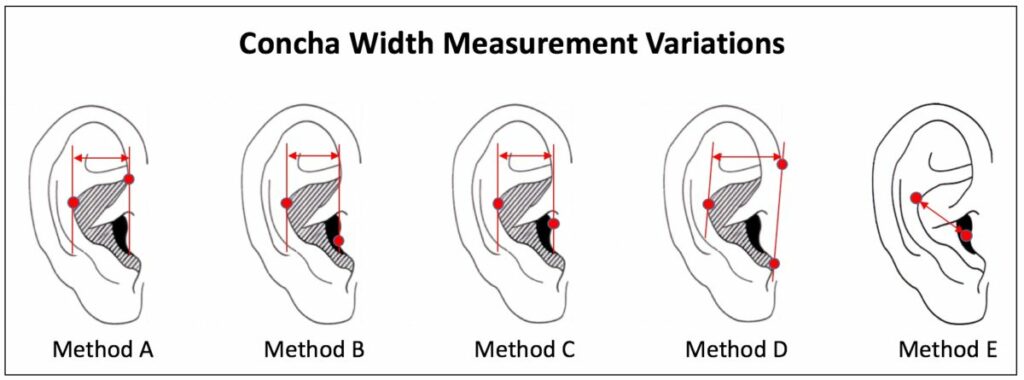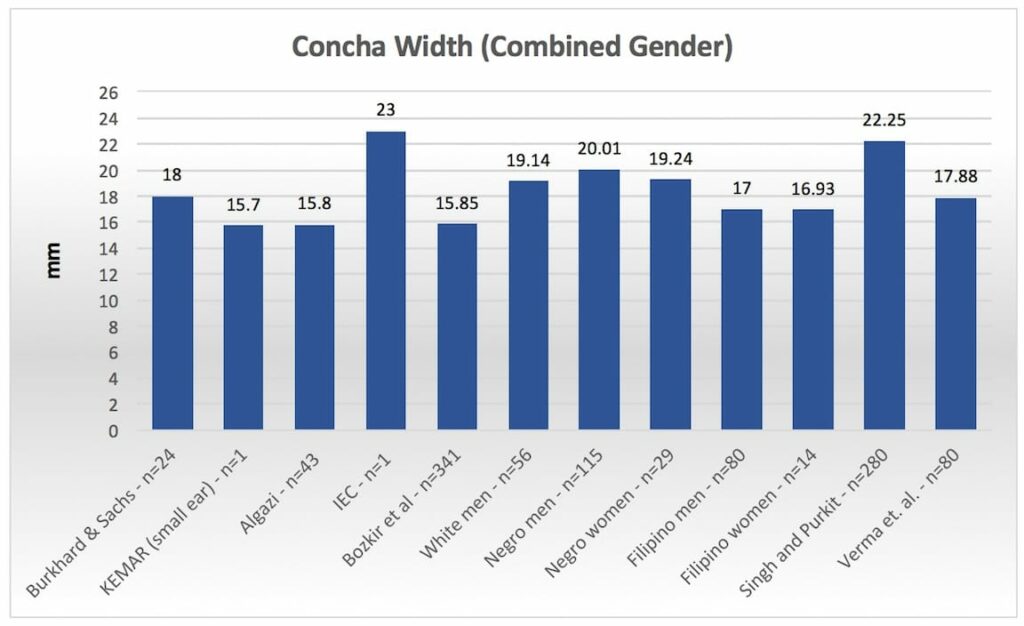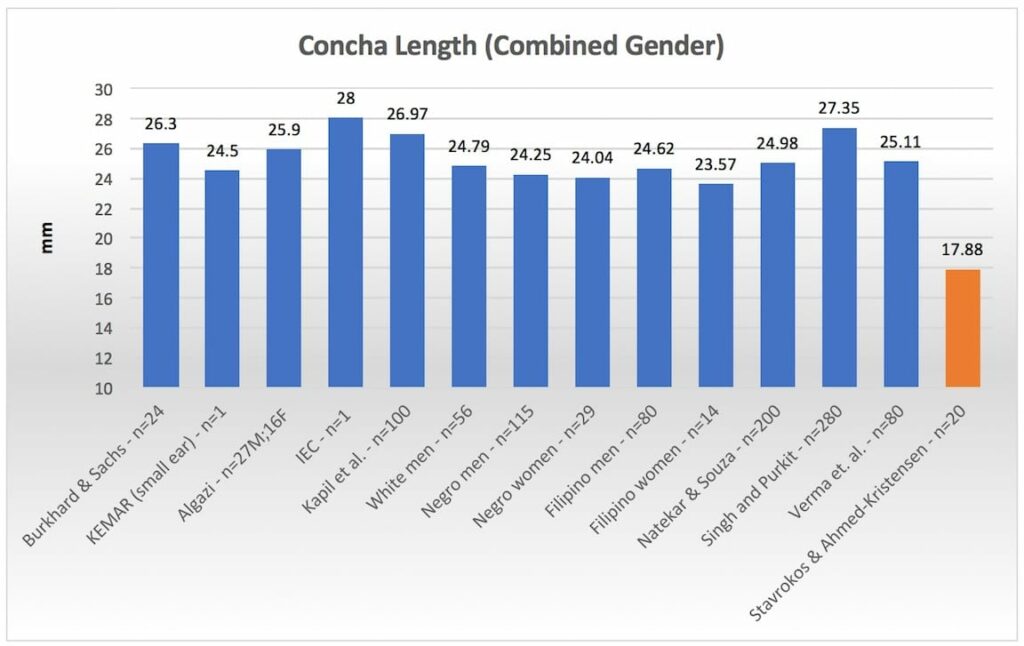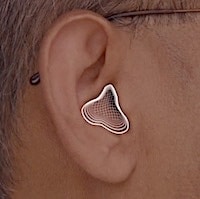It is interesting that although many products have been designed to be worn in the ear, there is little information specifically about the ear concha dimensions of the outer ear, the most likely location for placement and retention. This would seem to be of much more significance than many other ear measurements that have been made, especially for those who design products that are ear-worn and intended for the general consumer market, such as OTC (over-the-counter) hearing aids, earplugs, hearables, vital signs monitoring ear units, earbuds for acoustic listening, communications systems, etc.
A search shows that there is not much data on concha measurements. And, that of which there is, has been measured in a number of ways that makes comparisons difficult. It is likely that designers of in-ear products may have captured concha measurement data themselves, but when designing proprietary products, such data is not generally shared. Therefore, this post provides what published concha measurement data that could be found using a reasonable search time period.
Concha Depth

Figure 1. A method for concha depth determination. The depth should be measured to the deepest part of the concha on an angle orthogonal to a line connecting the tragus anteriorly and the outermost helix contact posteriorly.
Providing “real estate” for in-ear products is one of the most immediate critical mechanical requirements. A most popular method to make this measurement is shown in Figure 1. Figure 2 shows results of concha depth measurements for adult ears as reported by different researchers, with concha depth ranging from 9 mm to 16.8 mm. Unfortunately, measurement methods were not always provided, and the number of subjects varied considerably, both of which should be recognized when evaluating these data. Of the data in Figure 2, that by Burkhard & Sachs, Algazi, and Staab used the concha depth measurement identified in Figure 1. It was not clear how the other concha depth measurements were made.

Figure 2. Concha depth measurements in mm as reported in the anthropometric literature. The range is quite high, definitely reflecting differences in the methods used to record concha depth.
Concha Width
Concha width is measured in different ways among the articles reported in this post, as shown in Figure 3. For this reason, concha width data cannot be compared directly, even though different methods could produce similar results, depending on the shape of the concha. The only consistent measurement point seems to be that the measurement is made to the most posterior expansion of the concha. The anterior measurement landmark reference varies among the methods, as does how the distance between the reference points is measured.

Figure 3. Concha width measurement variations as identified in the references in this post. The red dots identify the anterior and posterior landmarks of the measurement.
Concha average width in mm is shown in Figure 4 for combined genders.

Figure 4. Concha width average measurements in mm for male and female ears. In all the studies identified in this graph, the genders have been combined, with the exception of where certain ethnic group genders have been identified.
Concha Length
Concha length measurements do not show significant differences in measurement. This is ordinarily described as being from the base of the intertragal notch to the maximum height of the concha cavum. Exceptions generally relate to adding the concha cavum height to the concha cymba height. However, a major departure is shown in Figure 5, identified by the orange bar. In this case, the concha height is described as measured from the base of the intertragal notch to the upper part of the concha cavum. In other words, the concha cymba was not considered to be included in the concha height dimension. Research data suggests that different ethnic populations have different sized conchae, but Figure 5 shows the range to be less than 4 mm.

Figure 5. Concha length (height) average measurements in mm for male and female ears. In all the studies identified in this graph, the genders have been combined, with the exception of where certain ethnic groups have been identified. The orange bar considered the concha height to extend from the base of the intertragal notch to the upper part of the concha cavum.
Gender Ear Concha Length and Width Comparisons
Essentially every measurement study of the auricle shows that the male ear is larger than the female ear. The same generalization holds true for concha length/height and width measurements, as shown in Figure 6. (The Bozkir et. al. data was confusing in the reference used, and should be rechecked because it seems to be at odds with all the other gender concha width comparisons).

Figure 6. Gender concha length/height and width differences in mm as reported in the literature. This comparison is based on studies that showed both genders’ length and width measurements.
Summary
Consumer and medical products are moving toward in-ear placement. Because of this, it would appear that ear measurements, primarily concha height, width, depth, volume, and configurations would be high on the list of important data. This is especially true for those products that are intended to fit multiple-sized conchae with relatively generic sizes(s).
References
Algazi, V.R, Duda, R.O., Thompson, D.M., Avendano, C. (2001). The CIPIC HRTF Database, IEEE Workshop on Applications of Signal Processing to Audio and Acoustics, 2001.
Bozkir MG, Karakas P, Yavuz M, Dere F (2006). Morphometry of the external ear in our adult population, Aesth. Plast. Surg., 30(1): 81-85.
Burkard MD, Sachs RM. (1975). Anthropometric manikin for acoustic research, Journal of the Acoustical Society of America, 58, 214-222.
Fels, J. From children to adults: how binaural cues and ear canal impedances grow. January 30, 2008. Von der Fakula ̈t fu ̈r Elektrotechnik und Informationstechnik der Rheinisch-Westfa ̈lischen Technischen Hochschule Aachen zur Erlangung des akademischen Grades einer DOKTORIN DER INGENIEURWISSENSCHAFTEN genehmigte Dissertation.
IEC-Publication 126 (1973). IEC reference coupler for the measurement of hearing aids using earphones coupled to the ear by means of ear inserts. Bureau Center. De la Comm. Electrotech. Int. Geneve, Suisse. Second edition.
Kapil V, Bhawana J, and Vikas K. (2014). Morphological variation of ear for individual identification in forensic cases: a study of an Indian population. Research Journal of Forensic Sciences, Vol. 2(1), 1-8, January.
Natekar PE, De Souza FM. Demarking and identifying points-reliable criteria for determination of sex from external ear. Indian J Otol 2012;18:24-27.
Sibbald, A. (2000). Virtual ear technology. Sensura Limited. Company publication.
Singh P, Purkit R. (2006). Anthropological study of human auricle. JIAFM, 28(2); 0971-0973.
Staab, W. (2002). Concha depth. Unpublished.
Stavrakos SK, and Ahmed-Kristensen A. (2012). Assessment of anthropometric methods in headset design. International Design Conference, Dubrovnik, Croatia, May 21-24.
Teranishi R, Shaw EAG. (1968). External-ear acoustic models with simple geometry. J Acoust Soc Am 44 :257-263.
Verma P, Sandhu HK, Verma KG, Goyal S, Sudan M. Ladgotra A. (2016). Morphological variations and biometrics of ear: an aid to personal identification. Journal of Clinical and Diagnostic Research. Vol. 10(5) 238-142.
Zwislocki J. (1970). An acoustic coupler for earphone calibration Rep. LSC-S-7. Laboratory of Sensory Communication, Syracuse University, Sept.






